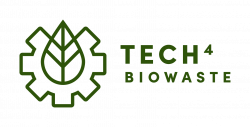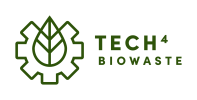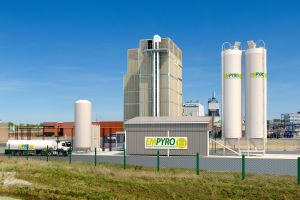Pyrolysis
| Technology | |

| |
| Technology details | |
| Name: | Pyrolysis |
| Category: | Conversion (Thermochemical processes and technologies) |
| Feedstock: | Garden and park waste (wood, leaves) |
| Product: | Coal, pyrolysis oil, pyrolysis gas |
Pyrolysis (from greek pyr, "fire" and lysis, "loosing/unbind") is a conversion technology that utilises a thermochemical process to convert organic compounds in presence of heat and absence of oxygen into valuable products which can be solid, liquid or gaseous. The chemical transformations of substances are generally accompanied by the breaking of chemical bonds which leads to the conversion of more complex molecules into simpler molecules which may also combine with each other to build up larger molecules again. The products of pyrolysis are usually not the actual building blocks of the decomposed substance, but are structurally modified (e.g. by cyclization and aromatisation or rearrangement).
Feedstock
Origin and composition
Since all kind of biowaste contains hydrocarbonaceous material it can also be processed via pyrolysis. However, the composition of the feedstock has an impact on the pyrolysis process and therewith on the products which can be obtained. Usually wood and herbaceous feedstocks are processed which are composed differently[1] which qualifies garden and park waste as suitable feedstock.
| Feedstock: | Corn stover | Switchgrass | Wood |
|---|---|---|---|
| Proximate analysis wt [%] | |||
| Moisture | 8.0 | 9.8 | 42.0 |
| Ash | 6.9 | 8.1 | 2.3 |
| Volatile matter | 69.7 | 69.1 | 47.8 |
| Fixed carbon | 15.4 | 12.9 | 7.9 |
| Elemental analysis [%] | |||
| Carbon | 49.7 | 50.7 | 51.5 |
| Hydrogen | 5.91 | 6.32 | 4.71 |
| Oxygen | 42.6 | 41.0 | 40.9 |
| Nitrogen | 0.97 | 0.83 | 1.06 |
| Sulphur | 0.11 | 0.21 | 0.12 |
| Chlorine | 0.28 | 0.22 | 0.02 |
| Structural organics wt [%] | |||
| Cellulose | 36.3 | 44.8 | 38.3 |
| Hemicellulose | 23.5 | 35.3 | 33.4 |
| Lignin | 17.5 | 11.9 | 25.2 |
Pre-treatment
The pre-treatment of the feedstock has an impact on the pyrolysis process, its efficiency, and the yield of certain products. The following pre-treatments may be considered [2]:
- Sizing (e.g. chipping, grinding)
- Densification (e.g. pressure-densification)
- Steam explosion
- Drying (e.g. air drying, freeze-drying)
- Extraction (e.g. acid and alkali treatment for the removal of minerals)
- Wet torrefaction
- Ammonia fibre expansion
- Composting (e.g. Decomposing via fungi)
Process and technologies
The pyrolysis is an endothermal process requiring the input of energy in form of heat which can either be directly (direct pyrolysis) applied via hot gases or indirectly (indirect pyrolysis) via external heating of the reactor. Compared to gasification, the process takes place in an atmosphere without oxygen or at least under a limitation of oxygen.
In general, pyrolysis can be divided into different steps which include:
- Evaporation and vapourisation of water and other volatile molecules which is induced at temperatures > 100 °C
- Thermal excitation and dissociation of the molecules induced at temperatures between 100-600 °C, which also may involve the production of free radicals as intermediate stage
- Reaction and recombination of the molecules, and triggering of chain reactions through free radicals
The pyrolysis process and the formation of products can be controlled to a certain extend via different temperature ranges and reaction times as well as by utilising reactive gases, liquids, catalysts, alternative forms of heat application (e.g. via microwaves or plasma), and a variety of reactor designs. Depending on the residence time and temperature as well as different technical reaction environments the pyrolysis can be categorised under diffferent terms as follows.
Categorisation according residence time and temperature
- Fast pyrolysis
- Intermediate pyrolysis
- Slow pyrolysis (charring, torrefaction)
Categorisation according technical reaction environment
Depending on these factors the pyrolysis technology can be divided into different categories as follows:
- Catalytic cracking
- One-step process
- Two-step process
- Hydrocracking
- Thermal cracking
- Thermal depolymerisation
Reactions
A range of different reactions occur during the process such as dehydration, depolymerisation, isomerisation, aromatisation, decarboxylation, and charring[2].
Product
A range of solid, liquid, and gaseous products can be obtained from the pyrolysis process including char, pyrolysis oil, and pyrolysis gas. Depending on the feedstock origin and composition as well as the pre-treatment and process the yield as well as the chemical and physical properties of the products can vary.
Char
As mentioned the functional properties of char may vary which includes carbon content, functional groups, heating value, surface area, and pore-size distribution. The application possibilities are versatile, the char can be used as soil amendment for carbon sequestration, soil fertility improvement, and pollution remediation. Furthermore the char can be used for catalytic purposes, energy storage, or sorbent for pollutant removal from water or flue-gas.
Pyrolysis oil
Produced pyrolysis oil is a multiphase emulsion composed of water and hundreds of organic molecules such as acids, alcohols, ketones, furans, phenols, ethers, esters, sugars, aldehydes, alkenes, nitrogen- and oxygen- containing molecules. A longer storage or exposure to higher temperature increases the viscosity due to possible chemical reactions of the compounds in the oil which leads to the formation of larger molecules[3]. The presence of oligomeric species with a molecular weight >5000 decreases the stability of the oil[2]. Furthermore, the formation of aerosols from volatile substances accelerates the aging process in which the water content and phase separation increases. The application as fuel in standard equipment for petroleum fuels (e.g. boilers, engines, turbines) may be limited due to poor volatility, high viscosity, coking, and corrosiveness of the oil[3]. To overcome these problems, the pyrolysis oil has to be upgraded in a post-treatment to be used as fuel and/or the equipment for the end-application has to be adapted.
Pyrolysis gas
Syngas can be obtained from the pyrolysis gas which is composed of different gases such as carbon dioxide, carbon monoxide, hydrogen, methane, ethane, ethylene, propane, suphur oxides, nitrogen oxides, and ammonia[2]. The different gases can be fractionated from each other in the post-treatment to utilise them for different applications such as the production of chemicals, cosmetics, food, polymers or the utilisation as fuel or technical gas.
Post-treatment
Technology providers
| Company name | Country | City | Technology subcategory | Technology name | TRL | Capacity [kg/h] | Catalyst | Reactor | Temperature [°C] | Feedstock: Food waste | Feedstock: Garden & park waste | Product: Char | Product: Oil | Product: Syngas |
|---|---|---|---|---|---|---|---|---|---|---|---|---|---|---|
| BioBTX | The Netherlands | Groningen | Catalytic Pyrolysis, two-step | Integrated Cascading Catalytic Pyrolysis (ICCP) technology | 5-6 | 10 | Zeolite | - | 450-650 | ● | ● | ● | ● | |
| BTG Bioliquids | The Netherlands | Hengelo | Fast Pyrolysis | BTG fast pyrolysis technology | 8-9 | 5,000 | None | Rotating Cone | 400-550 | ● | ● | ● | ||
| Splainex Ecosystems | The Netherlands | Rijswijk | Pyrolysis | Waste pyrolysis industrial plants | 7-9 | 65,000 | - | - | 400-700 | ● | ● | ● | ● | ● |
| VTT Technical Research Centre of Finland | Finland | Espoo | Pyrolysis | Pyrolysis technology | 6 | 154 | - | - | - | ● | ● | ● | ● |
BioBTX
| General information | |||
| Company: | Bio-BTX B.V. | 
| |
| Country: | The Netherlands | ||
| Contact: | |||
| Webpage: | https://biobtx.com/ | ||
| Technology and process details | |||
| Technology name: | Integrated Cascading Catalytic Pyrolysis (ICCP) technology | Technology category: | Conversion (Thermochemical processes and technologies) |
| TRL: | 5-6 | Capacity: | 10 kg·h-1 |
| Atmosphere: | Inert | Catalyst: | Zeolite |
| Heating: | Fluidised sand bed | Pressure: | 1-4 bar |
| Reactor: | Fluidised sand bed, fixed bed | Temperature: | 450-650 °C |
| Other: | Unknown | ||
| Feedstock and product details | |||
| Feedstock: | Biomass (liquid, solid), wood pulp lignin residues, used cooking oil | Product: | Benzene, toluene, xylene, aromatics, light gases |
BioBTX was founded in 2012 by KNN and Syncom in collaboration with the university of Groningen, Netherlands. The company is a technology provider developing chemical recycling technologies for different feedstocks including non-food bio- and plastics waste. In 2018 a pilot plant with the capability to process biomass and plastic waste was set up at the Zernike Advanced Processing (ZAP) Facility. The company is now focused on setting up their first commercial plant with a capacity of 20,000 to 30,000 tonnes. The investing phase B was recently completed, with the last investment phase in 2019 the financial requirements are fulfilled to complete the commercialisation activities to build the plant which is expected for 2023.
The technology is based on an Integrated Cascading Catalytic Pyrolysis (ICCP) process, being able to produce aromatics including benzene, toluene, and xylene (BTX) as well as light olefins from low grade biomass and plastics waste. This technology utilises catalytic cracking in a two-step process at temperatures between 450- 850 °C. In the first step the feedstock material is vaporised via thermal cracking. The pyrolysis vapours are then directly passed into a second reactor in which they are converted into aromatics by utilising a zeolite catalyst which can be continuously regenerated. Finally, the products are separated from the gas via condensation. An ex situ approach of catalytic conversion has several advantages such as the protection of the catalyst from deactivation/degradation expanding its lifetime, a greater variety of feedstock, and a precise adjustment of process conditions (e.g. temperature, catalyst design, and Weight Hourly Space Velocity (WHSV) in each step for improved yields. In current pilot plant with 10 kg h-1 feed capacity for either waste plastics or biomass, final design details are established, which will be include in the running engineering activities for the commercial plant.
BTG Bioliquids
| General information | |||
| Company: | BTG Bioliquids | ||
| Country: | The Netherlands | ||
| Contact: | mark.richters@btg-bioliquids.com | ||
| Webpage: | https://www.btg-bioliquids.com/ | ||
| Technology and process details | |||
| Technology name: | BTG fast pyrolysis technology | Technology category: | Conversion (Thermochemical processes and technologies) |
| TRL: | 8-9 | Capacity: | 5,000 kg·h-1 |
| Atmosphere: | Inert | Catalyst: | None |
| Heating: | Fluidised sand bed | Pressure: | n.a. bar |
| Reactor: | Rotating Cone Reactor | Temperature: | 400-550 °C |
| Other: | |||
| Feedstock and product details | |||
| Feedstock: | Woody biomass | Product: | Fast Pyrolysis Bio-Oil (FPBO), heat (steam), power (electricity) |
BTG Bioliquids, a spin-off company from BTG Biomass Technology Group, was founded in 2007 in Enschede, the Netherlands. BTG Bioliquids aims for commercial implementation of their fast pyrolysis technology, which focuses on converting biomass residues into Fast Pyrolysis Bio Oil (FPBO). Since 2015, the first successful production plant EMPYRO is in operation in Hengelo, the Netherlands, producing 24,000 tonnes pyrolysis oil per year. In 2018 EMPYRO was sold to Twence. In addition 2 FPBO-plants in Scandinavia are in commercial production at Green Fuel Nordic in Finland and Pyrocell in Sweden. Several other customer projects are under discussion in Europe and North America.
Splainex Ecosystems
| General information | |||
| Company: | Splainex Ecosystems | 
| |
| Country: | The Netherlands | ||
| Contact: | www.splainex.com/pyrolysis-company-contact.html | ||
| Webpage: | www.splainex.com | ||
| Technology and process details | |||
| Technology name: | Waste pyrolysis industrial plants | Technology category: | Conversion (Thermochemical processes and technologies) |
| TRL: | 7-9 | Capacity: | 65,000 kg·h-1 |
| Atmosphere: | Inert | Catalyst: | |
| Heating: | Pressure: | bar | |
| Reactor: | Temperature: | 400-700 °C | |
| Other: | |||
| Feedstock and product details | |||
| Feedstock: | MSW, RDF, Sewage sludge, Wooden biomass | Product: | Pyrolysis oil, pyrolysis gas, biochar, energy |
In 2007 Splainex Ecosystems was founded originating from Splainex which was founded in 1994. The main focus of the company is the design and supply of pyrolysis plants, focussing on the pyrolysis unit equipment i.e. pyrolysis furnace, combustion chamber for energy recovery, char cooler. Quality equipment is supplied by their German partners. Offered services include project initiation/feasibility study, design and engineering, equipment fabrication and procurement, factory acceptance testing, packing and shipment, supply, on-site assistance with construction, commissioning, and start-up. Turn-key project delivery is also possible (mostly limited to Europe).
VTT Technical Research Centre of Finland
| General information | |||
| Company: | VTT Technical Research Centre of Finland | 
| |
| Country: | Finland | ||
| Contact: | www.vttresearch.com/en/about-us/contact-us | ||
| Webpage: | www.vttresearch.com | ||
| Technology and process details | |||
| Technology name: | Pyrolysis technology | Technology category: | Conversion (Thermochemical processes and technologies) |
| TRL: | 6 | Capacity: | 154 kg·h-1 |
| Atmosphere: | Inert | Catalyst: | |
| Heating: | Pressure: | bar | |
| Reactor: | Temperature: | °C | |
| Other: | |||
| Feedstock and product details | |||
| Feedstock: | Biomass waste | Product: | Pyrolysis oil, wax, char |
The VTT Technical Research Centre is a non-profit organisation owned and controlled by the state. The strategy is to support businesses and society to work on global challenges through research, innovation, and information. The research centre covers a wide range of topics such as biotechnology, circular economy, climate action, energy, plastics, and renewable and recyclable materials. VTT has a long-time experience in fast pyrolysis and realised one of VTT’s patent on biomass pyrolysis in 2006, on which a plant for bio oil production in Finland with a capacity of 10 tonnes per hour was established by Metso, UPM, and Fortum. A pilot scale with a capacity of 20 kg h-1 as well as bench scale plants with a capacity of 1-2 kg h-1 are available.
Open access pilot and demo facility providers
Patents
Currently no patents have been identified.
References
Al Arni, S. 2018: Comparison of slow and fast pyrolysis for converting biomass into fuel. Renewable Energy, Vol. 124 197-201. doi:https://doi.org/10.1016/j.renene.2017.04.060
Czajczyńska, D., Anguilano, L., Ghazal, H., Krzyżyńska, R., Reynolds, A. J., Spencer, N. and Jouhara, H. 2017: Potential of pyrolysis processes in the waste management sector. Thermal Science and Engineering Progress, Vol. 3 171-197. doi:https://doi.org/10.1016/j.tsep.2017.06.003
Speight, J. 2019: Handbook of Industrial Hydrocarbon Processes. Gulf Professional Publishing, Oxford, United Kingdom.
Tan, H., Lee, C. T., Ong, P. Y., Wong, K. Y., Bong, C. P. C., Li, C. and Gao, Y. 2021: A Review On The Comparison Between Slow Pyrolysis And Fast Pyrolysis On The Quality Of Lignocellulosic And Lignin-Based Biochar. IOP Conference Series: Materials Science and Engineering, Vol. 1051 doi:10.1088/1757-899X/1051/1/012075
Waheed, Q. M. K., Nahil, M. A. and Williams, P. T. 2013: Pyrolysis of waste biomass: investigation of fast pyrolysis and slow pyrolysis process conditions on product yield and gas composition. Journal of the Energy Institute, Vol. 86 (4), 233-241. doi:10.1179/1743967113Z.00000000067
Zaman, C. Z., Pal, K., Yehye, W. A., Sagadevan, S., Shah, S. T., Adebisi, G. A., Marliana, E., Rafique, R. F. and Johan, R. B. 2017: Pyrolysis: A Sustainable Way to Generate Energy from Waste. IntechOpen
- ↑ a b Carpenter, D., Westover, T. L., Czernik, S. and Jablonski, W., 2014: Biomass feedstocks for renewable fuel production: a review of the impacts of feedstock and pretreatment on the yield and product distribution of fast pyrolysis bio-oils and vapors. Green Chemistry, Vol. 16, (2), 384-406. doi: https://doi.org/10.1039/C3GC41631C
- ↑ a b c d Hu, X. and Gholizadeh, M., 2019: Biomass pyrolysis: A review of the process development and challenges from initial researches up to the commercialisation stage. Journal of Energy Chemistry, Vol. 39, 109-143. doi: https://doi.org/doi:https://doi.org/10.1016/j.jechem.2019.01.024
- ↑ a b Czernik, S. and Bridgwater, 2004: Overview of Applications of Biomass Fast Pyrolysis Oil. Energy & Fuels, Vol. 18, (2), 590-598. doi: https://doi.org/10.1021/ef034067u


